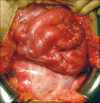Sclerosing encapsulating peritonitis after living-donor liver transplantation: A case series, Kyoto experience
- PMID: 29896575
- PMCID: PMC5981144
- DOI: 10.14701/ahbps.2018.22.2.144
Sclerosing encapsulating peritonitis after living-donor liver transplantation: A case series, Kyoto experience
Abstract
Sclerosing encapsulating peritonitis (SEP), or abdominal cocoon is a rare cause of intestinal obstruction, and still etiology remains unknown. We report a series of 4 patients with abdominal cocoon, and all the 4 patients had previously undergone living-donor liver transplantation (LDLT). There was no evidence of SEP before and during LDLT. At the time of diagnosis of SEP, 3 out of 4 patients had ascites. First and fourth patients had multiple episodes or attacks of cholangitis, which were managed by percutaneous transhepatic biliary drainage and hepaticojejunostomy, respectively. All 4 patients presented with intestinal obstruction and 3 of them underwent a successful operation. The fourth patient died due to liver failure and complications of the SEP. The first 3 patients are doing well without SEP recurrence. Our experience suggest that the prognosis of SEP is poor in patients with poor graft liver functions after LDLT.
Keywords: Abdominal cocoon; Intestinal obstruction; Liver transplantation; Sclerosing encapsulating peritonitis.
Figures







Similar articles
-
Primary Sclerosing Encapsulating Peritonitis (PSEP) With Meckel's Diverticulum: A Rare Case Report.Cureus. 2023 May 30;15(5):e39756. doi: 10.7759/cureus.39756. eCollection 2023 May. Cureus. 2023. PMID: 37398790 Free PMC article.
-
Sclerosing encapsulating peritonitis (Abdominal Cocoon) associated with Non-Hodgkin's lymphoma of bowel wall: a rare case report.Ann Med Surg (Lond). 2024 Nov 18;87(2):900-907. doi: 10.1097/MS9.0000000000002710. eCollection 2025 Feb. Ann Med Surg (Lond). 2024. PMID: 40110321 Free PMC article.
-
Sclerosing encapsulating peritonitis: three case reports and review of the literature.J Int Med Res. 2020 Aug;48(8):300060520949104. doi: 10.1177/0300060520949104. J Int Med Res. 2020. PMID: 32811273 Free PMC article. Review.
-
Abdominal cocoon syndrome (idiopathic sclerosing encapsulating peritonitis): An extremely rare cause of small bowel obstruction-Two case reports and a review of literature.Front Med (Lausanne). 2022 Oct 12;9:1003775. doi: 10.3389/fmed.2022.1003775. eCollection 2022. Front Med (Lausanne). 2022. PMID: 36314018 Free PMC article.
-
Accurate definition and management of idiopathic sclerosing encapsulating peritonitis.World J Gastroenterol. 2015 Jan 14;21(2):675-87. doi: 10.3748/wjg.v21.i2.675. World J Gastroenterol. 2015. PMID: 25593498 Free PMC article. Review.
Cited by
-
A case of encapsulating peritoneal sclerosis in a patient with chronic schistosomiasis.IDCases. 2021 Apr 12;24:e01123. doi: 10.1016/j.idcr.2021.e01123. eCollection 2021. IDCases. 2021. PMID: 33912393 Free PMC article.
-
Imaging and treatment of idiopathic abdominal cocoon in 9 patients.Exp Ther Med. 2020 Jan;19(1):651-657. doi: 10.3892/etm.2019.8258. Epub 2019 Nov 29. Exp Ther Med. 2020. PMID: 31885704 Free PMC article.
-
A Case Series and Brief Review of Literature on Encapsulating Peritoneal Sclerosis: Unveiling the Cocoon.Cureus. 2024 Nov 16;16(11):e73802. doi: 10.7759/cureus.73802. eCollection 2024 Nov. Cureus. 2024. PMID: 39687804 Free PMC article.
References
-
- Yip FW, Lee SH. The abdominal cocoon. Aust N Z J Surg. 1992;62:638–642. - PubMed
-
- Godlewski G, Kadi B, Branger B, Vécina F, Deschodt G, Joujoux JM, et al. Encapsulating peritonitis after chronic peritoneal dialysis. Apropos of 3 cases. Chirurgie. 1993-1994;119:686–689. discussion 690. - PubMed
-
- Holland P. Sclerosing encapsulating peritonitis in chronic ambulatory peritoneal dialysis. Clin Radiol. 1990;41:19–23. - PubMed
-
- Maguire D, Srinivasan P, O'Grady J, Rela M, Heaton ND. Sclerosing encapsulating peritonitis after orthotopic liver transplantation. Am J Surg. 2001;182:151–154. - PubMed
-
- Mekeel K, Moss A, Reddy KS, Douglas D, Mulligan D. Sclerosing peritonitis and mortality after liver transplantation. Liver Transpl. 2009;15:435–439. - PubMed
Publication types
LinkOut - more resources
Full Text Sources
Other Literature Sources
